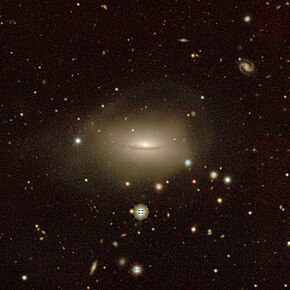| NGC 3007 | |
|---|---|
 legacy surveys image of NGC 3007 | |
| Observation data (J2000 epoch) | |
| Constellation | Sextans |
| Right ascension | 09h 47m 45.620s[1] |
| Declination | −06° 26′ 17.40″[1] |
| Redshift | 0.02175[1] |
| Heliocentric radial velocity | 6520 km/s[1] |
| Distance | 330.3 ± 23.2 Mly (101.27 ± 7.11 Mpc)[1] |
| Apparent magnitude (B) | 14.41[2] |
| Characteristics | |
| Type | S0/a[1] |
| Other designations | |
| MCG -01-25-038, PGC 28150 | |
NGC 3007 is an edge-on, magnitude 13.4, lenticular galaxy in the constellation of Sextans,[3] discovered by Édouard Stephan on March 16, 1855.[4] It is about 115 thousand light years across, and with a recessional velocity of 6,520 kilometers per second, is at a distance of over 300 million light-years from the Sun.[4]
References[edit]
- ^ a b c d e f "Results for object NGC 3007 (NGC 3007)". NASA/IPAC Extragalactic Database. California Institute of Technology. Retrieved 2021-02-14.
- ^ "Search specification: NGC 3007". HyperLeda. Université Claude Bernard Lyon 1. Retrieved 2021-02-14.
- ^ "NGC 3007". in-the-sky.org. Retrieved 6 April 2020.
- ^ a b "Celestial Atlas". cseligman.com. Retrieved 6 April 2020.
Well, that’s interesting to know that Psilotum nudum are known as whisk ferns. Psilotum nudum is the commoner species of the two. While the P. flaccidum is a rare species and is found in the tropical islands. Both the species are usually epiphytic in habit and grow upon tree ferns. These species may also be terrestrial and grow in humus or in the crevices of the rocks.
View the detailed Guide of Psilotum nudum: Detailed Study Of Psilotum Nudum (Whisk Fern), Classification, Anatomy, Reproduction